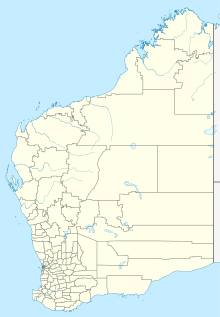Monkey Mia
Coordinates: 25 ° 47 ′ 41 ″ S , 113 ° 43 ′ 2 ″ E
The beach of Monkey Mia on the north-eastern large peninsula of Shark Bay in Western Australia , which is largely a UNESCO World Heritage Site, is famous for the wild dolphins that come to the beach several times in the morning to be hand-fed.
Rangers from the West Australian Nature Conservation Authority monitor the spectacle and look after the visitor center , which was set up in 2001 and provides information about the life of the dolphins through video films, permanent exhibitions and literature.
The origin of the "monkey" name of the bay is unclear.
The resort for dolphin feeding
The story of Monkey Mia began in the 1960s, began as a local fisherman, occasionally passing by bottlenose dolphins ( bottlenose dolphins ) to feed on fish waste. The animals gradually got used to the feeding and regularly appeared in the early morning and in the morning hours near the beach.
After more and more onlookers gathered, the systematic tourist marketing of this campaign began in the 1980s by creating the necessary infrastructure. Today's extensive resort consists of an apartment complex with sports facilities and a restaurant as well as a backpacker section with camping huts. There is also a very small area for tents for the size of the resort.
When the first dolphins are spotted on the beach - usually around 8 a.m. - the rangers announce the upcoming feeding via the public address system. Usually six to eight dolphins come by, but in exceptional cases over 20 have been seen at once. The rangers recognize them by their different dorsal fins and have given them names.
While around 100–400 tourists stand knee-deep in the water, depending on the season, a ranger explains the identity of the animals - via loudspeaker - and reports about their latest experiences with them for around 20 minutes. Then other rangers appear with 2-3 small buckets full of fish; now all tourists have to get out of the water and stand on the beach. Tourists selected by the rangers are then allowed to feed the dolphins. At no time should the dolphins be stroked or touched, as this can transmit diseases to the dolphins.
At the same time as the dolphins, the spectacle pelicans are fed with pieces of fish at the upper end of the beach . In this way, the rangers prevent the pelicans from trying to get the dolphin food and attacking the tourists in the process.
In the course of the morning there is usually one or two more feedings, depending on whether and how many dolphins come again. These feedings are usually less frequented, as most tourists take part in the first action in the early morning and then continue their journey.
The resort advertises with a "hit rate" of 99.6%, in other words: within two years there have only been two "dolphin-free" days.
Destinations in the area
- A 1.5 km long hiking trail behind the resort leads to a bird watching station.
- Boat trips are organized to see the dolphins in the wild (on the open sea) as well as to watch dugongs , tiger sharks , sea turtles and whales .
- The most important place in the region is the former pearl fishing village Denham , which is also the administrative center of the Shire of Shark Bay .
- The Monkey Mia Road , which leads from Denham to the resort and ends there, runs along the southern edge of the Francois Peron National Park . The bushland with rust-red sand dunes is a nature reserve for numerous endangered animal species.
- The Shell Beach from millions of cockles the type Fragum erugatum is located about 40 km south of Monkey Mia.
- Another 30 km south is the Hamelin Pool Marine Nature Reserve . At the telegraph station from 1884 there is a small museum in which the stromatolites in the Hamelin Pool, a few steps away, are explained: in the bay, microorganisms still form small mushroom-shaped rocks as they did two or three billion years ago. This phenomenon, which was probably one of the first life forms on earth , can only rarely be observed.
literature
Günther, Janine / Mohr, Jens: Westaustralien und das Top End, Verlag 360 °, 1st edition 2005
Web links
- Monkey Mia Resort , RAC Monkey Mia Dolphin Resort
- Monkey Mia Reserve , Official Website


